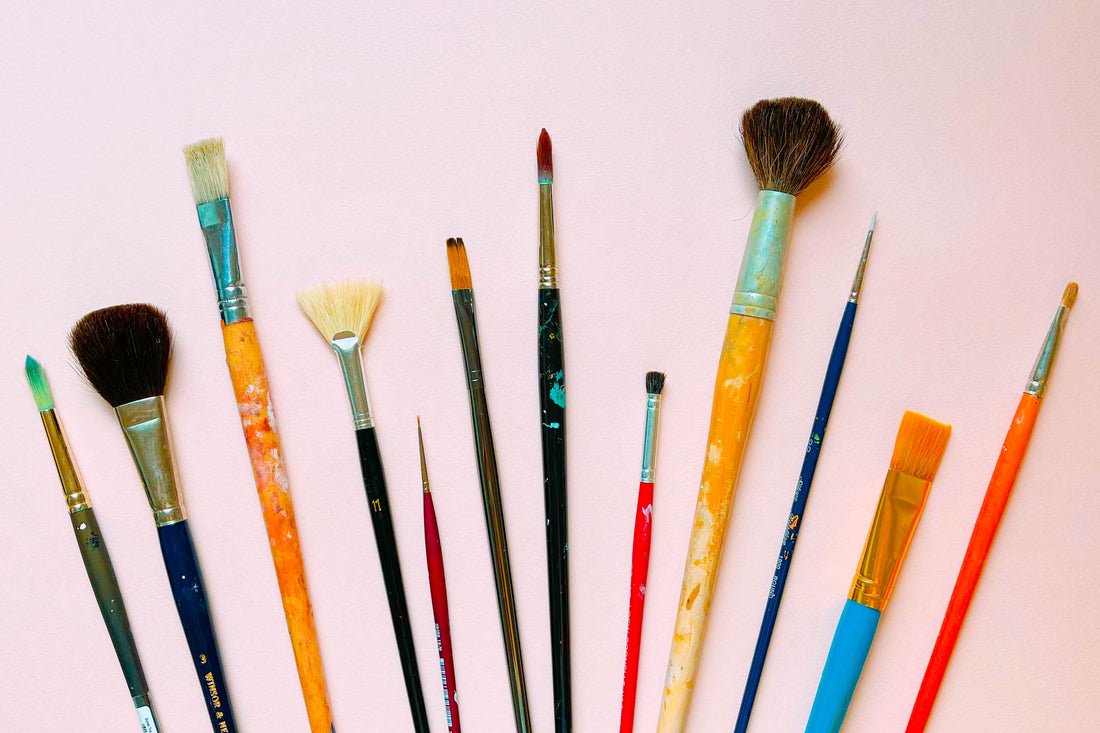Art tools can get expensive. So, it’s always best to take good care of them. Help them lead a long, happy life in your studio. But that’s easier said than done. Trust me, I know!
I am the queen of being messy while I work. But the reason I’m messy is that most of my work is scanned into my computer, then manipulated in Photoshop. I’m not worried about all the imperfections as they can be cleaned up on the computer. However... I think that “messiness” in my painting process carries over into how I care for my paintbrushes – you do the math.
I keep a variety of brushes on hand: professional brushes for originals and art that might go to a client, and student-grade for those quick renderings that get scanned. And, student-grade brushes are cheaper and easier to replace. However, that’s not really a long-term plan (nor an environmentally-friendly one!)
So, it’s always best to know how to effectively clean your paintbrushes. Let’s get to it!
Here are my 5 best tips for keeping your acrylic paint brushes clean:

1) Keep Your Brushes Moist (aka, don’t let paint dry out on your brush)
If paint does dry on your brush, there is a backup remedy that might just save your brush (see Number 4 below). But the best practice is to wash your brush after each use of a color. Acrylic paint is insoluble and will NOT dissolve the next time it gets wet. As you’re working, do your best to swirl your brush around in the water and dab on a paper towel to remove as much paint as possible. Feel free to use a brush scrubber at the bottom of your water glass to help remove excess paint while you work.
2) Keep The Ferrule Free From Paint Build Up
The ferrule is the metal clamp that holds the bristles to the handle and, inevitably, we all get paint smothered up around the ferrule. If you do get paint blotched up near this clamp, wash immediately to remove the excess paint. If paint dries in the ferrule, it can damage your bristles and cause them to split at the ends. Gently use your fingers to pry any dried paint that might have hardened around the ferrule.

3) Lay Your Brushes Flat While You Work
It’s easy to leave your brush in a glass of water when you’re not using it (hey, we’re all guilty!), but your brush’s tip can start to bend over time. Plus, any water build-up within the ferrule can start to damage its structure. It’s best to lay your brushes down flat on a paper towel while you work. You can thoroughly clean them at the end of your painting session with soap and water for a deeper clean (see Number 4).
4) Rinse With Soap And Condition
Time for today’s brush cleaning tutorial, “The Thorough Cleanse!”
Firstly, take mild soap and water and gently massage through the bristles of your brush. Try to remove as much paint as possible. Dab your brush on paper towel to make sure all the paint is removed. You can also use brush soaps, such as Chelsea Classical Studio Lavender & Olive Oil Soap and Da Vinci All Natural Brush Soap with Conditioner.
If paint does dry up on your brushes, the Winsor & Newton Brush Cleaner and Restorer completely cleans dried acrylics with no damage to the brush head or loss of fibers. It can be used on natural or synthetic brushes.
Another alternative is to use rubbing alcohol. Place the alcohol in a jar and let your brush sit in it for at least five minutes. Use rubber gloves or an old toothbrush to remove any dried paint. Rubbing alcohol can dry your brushes out over time so be sure to use a conditioner, such as The Masters Brush Cleaner and Preserver to help restore the bristles.

5) Reshape Your Brushes
After your brushes are completely clean, reshape the bristles back into their original shape while still wet. If using a round or liner brush, squeeze the bristles to a point without twisting the hairs. If using a flat or chisel brush, pinch the edges so the brush becomes completely flat at the tip. Lay your brushes down flat to dry. If you keep them upright when wet, water can penetrate the ferrule and cause the clamp to be compromised.
You can prolong the life of your natural and synthetic brushes with the Mona Lisa Brush Shaper. This solution stiffens and re-shapes bristles without harming the brush or the environment. Once your brush is clean and all paint has been removed from the bristles, dip it into Brush Shaper. Using your fingers, re-shape the brush to its original form and set it aside to dry.
Here’s to a long life for your paintbrush family!



